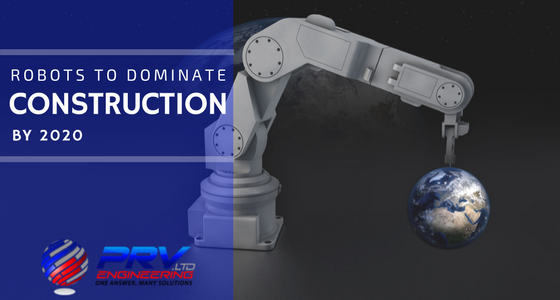Construction is a $10 trillion global industry and robots are set to revolutionise the industry by 2020. Productivity in manufacturing, retail and agriculture has grown exponentially since 1945 but it has barely gone up in construction. How will robots be used to increase productivity and if they do, how will it impact the workforce?
Report: Robotics in Construction
A recent report from the World Economic Forum suggests that robots will take over more than 5.1 million jobs with 10% in the construction industry. Majority of the jobs automation will replace are the repetitive and mundane requiring a small amount of decision making. The report reflects data from interviews with human resources staff from 371 companies around the globe.
Although some regard robotics as a threat, some see it as a positive change. Balfour Beatty, an international construction company, claims that automation could create new roles for skilled workers in certain areas. Although commendable, what about the many unskilled and vulnerable workers who are unlikely to be retrained or upskilled?
According to the chief executive at Balfour Beatty, Leo Quinn, “We are experiencing a digital revolution, redefining how we as an industry operate; becoming faster, better and more agile. By adopting and embracing the rise of digital solutions we are more able to deliver efficient, effective and safer solutions to our clients and customers. These changes will mean we have to ensure our industry trains our current and future employees with the skills to exploit the use of new technology, new materials and new methods of working.”
The report also suggests that re-training of employees into specialised roles related to automation should start as soon as possible. Companies need to prepare for the inevitable shift as was the case during the previous industrial revolution. Here, the increase of new technology was slow enough to allow everyone to adapt but only time will tell if the same will happen now.
In conclusion, the report indicates that “Without targeted action today to manage the near-term transition and build a workforce with future-proof skills, governments will have to cope with ever-growing unemployment and inequality, and businesses with a shrinking consumer base.”
Robotic Applications In Construction
Although construction relies heavily on manual processes, there are a number of exciting new applications. Komatsu, for example, has built a multi-purpose drone and bulldozer automation system with American start-up, Skycatch. The drone flies over a construction site while monitoring deliveries, inventory and the overall progress. In addition, the drone also creates a 3D map of the construction site and feeds it to an unmanned bulldozer. Although these construction sites are not yet fully automated, it is on the right track with Komatsu investing heavily in Smart Construction.
Another promising example is the combination of a 3D printer with robotic arm by the Chinese company WinSun. The robotic arm controls the motion of the 3D printer, allowing it to create large structures in no time at all. The company made global headlines in 2013 when they made 10 houses in one day using the first continuous 3D printer for construction.
Robots used to manufacture construction goods, whether its I-beams or insulation panels, are becoming more advanced and growing in popularity all across the globe. Although a few robots exist on the construction site, majority of them operate within the fabrication process. They predominantly build construction machinery, arc welding, apply adhesives and assemble doors or windows.
FANUC Robotics is also working on increasing the efficiency of building construction materials using robotic systems. Robots that cut, stack, bundle, package and palletize increases efficiency as they perform tasks much faster and with increased accuracy.
Whether everyone agrees or not, construction is ready for automation. We need to improve productivity and address labour shortages. In almost every scenario, Artificial Intelligence technologies complete tasks faster, more effectively and safer than their human counterparts.
Final Thoughts
Construction is a dangerous job and robots could improve worker safety by taking over some of the more dangerous tasks. This will allow human workers to complete more cognitive tasks. Even the smallest of differences in operating expenses can result in huge savings. Fewer site incidents means lower operating costs that could mean considerable savings for construction companies in the long run.
In many places people are still wary about collaborating with robots especially those doing jobs typically handled by humans. It comes down to implementing it systematically, keeping in mind the negative effects and not just focusing on the positives.
How do you feel about the effects robotics could have on the construction industry? Are you on the fence, totally against or in favour of a smooth transition? We’d love to hear from you in the comments section below or on Twitter, Facebook, Google+ or LinkedIn using #PRVTech.
Get in touch if you have any questions or if you need assistance with your project. We specialise in a number of sectors including fabrication, architectural steelwork among others.


Recent Comments